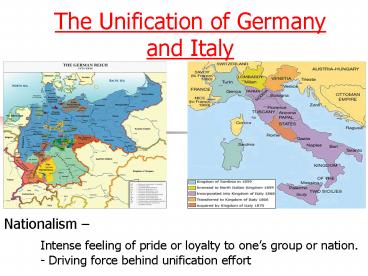The Unification of Germany and Italy PowerPoint PPT Presentation
1 / 13
Title: The Unification of Germany and Italy
1
The Unification of Germany and Italy
- Nationalism
- Intense feeling of pride or loyalty to ones
group or nation. - Driving force behind
unification effort
2
German Unification
- Early forms of unification
- Junkers
- Influential aristocratic landowners
- Persuaded Prussias leaders to do away with
Tariffs (breaks down trade barriers) - Zollverein
- Economic Union
- Reduced tariffs, other trade barriers
- Made uniform system of currency, and weights
3
PrussiaOtto Von Bismarck
- Appointed Prime Minister of Prussia by King
William I - Believed in strong government and powerful army
- Realpolitik (politics of reality)
- Blood and Iron speech
- War...if justified...could be used as a method of
expanding German interests
4
3 Wars
- War Against Denmark (1864)
- Dispute over Schleswig and Holstein
- Defeated by Prussia and Austria
- Schleswig to Prussia
- Holstein to Austria
- Seven Weeks War (1866)
- Prussia vs. Austria
- Prussia wins
- Ended chance of Austria being in control of
Germany - North German Confederation (1867)
- North of Main River
- Southern States
- Catholic
5
3 Wars (Continued)
- Franco-Prussian War
- Prince Leopold of Hohenzollern offered Spanish
throne - Cousin of William I of Prussia
- Napoleon III against this move
- No Hohenzollern on Spanish throne
- War begins July 19, 1870
- Southern states join northern states
- Prussians easily defeat French (4 months)
- Gain access to Alsace and Lorraine (France
bitter)
6
Formation of an Empire
- German states officially united (1871)
- technically separatebut united too
- (Kind of like our own 13 colonies)
- William I
- Kaiser
- Bismarck
- Chancellor
7
The Unification of Italy
8
Early Unification efforts
- Italian Nationalism
- Risorgimento (resurgence or revival)
- Desire for national independence
- Spurs effort to unite Italy
- Young Italy
- Giuseppe Mazzini (founder)
- Leads uprising Sicily (1848)
9
Piedmont (Sardinia)Count Camillo di Cavour
- Count Cavour
- Appointed Prime Minister by King Victor
- Emmanuel II
- Goals
- Industrial Growth
- Increase Piedmonts national interest in foreign
affairs by siding with foreign powers - Not a military power (have to be more diplomatic
than Prussia) - Ex. - Supported France and Britain in Crimean War
10
War with Austria
- France joins Piedmont against Austria
- Lombardy to Piedmont
- Austria keeps Venetia
- Cavours success leads to more rebellion in other
areas - Tuscany, Parma, Modena, Romagna demand to be
joined with Piedmont - April 1860
- Emmanuel II accepts the territories
- Savoy and Nice are given to France
11
Southern Italy
- Giuseppe Garibaldi
- Leader of nationalist group (Red Shirts) in
Southern Italy - Exiled after being part of a revolt
- Went to South America (Brazil) becomes an
expert in guerrilla warfare - 1860 takes control of Kingdom of Two Sicilies
- South is United with North 1861
- Garibaldi yields to Piedmont
- New state of Italy proclaimed 1861
12
Venetia and Rome
- Italy allies itself with Prussia (at war with
Austria) - Acquires Venetia
- Rome
- acquired due to Franco-Prussian War
- French troops pull out of Rome
- Emmanuel II moves capital from Florence to Rome
- Italy formally recognized as independent state in
1871
13
Similarities and Differences
- Ways the two unifications are similar
- Timing similar time frame (1815-1871) Why?
- Congress of Vienna v. Enlightenment
- Use military to achieve goals (involved in
multiple wars) - Two major kingdoms/prime ministers lead way for
unification (Prussia/Bismarck and
Piedmont/Cavour) - Split between North and South
- Ways they are different
- Prussia has much stronger military force than
Piedmont Piedmont must rely more on alliances - Italian unification involves multiple leaders
(Mazzini, Cavour, Victor Emmanuel II, and
Garibaldi) and various nationalist groups to
rally people. Not that German unification does
not involve multiple leaders but Bismarck is the
dominant figure in German unification.

